2000s in music
This article includes an overview of the major events and trends in popular music in the 2000s.
Overview
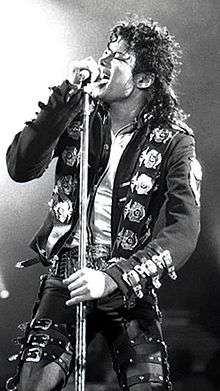
The 2000s were, for the most part, nondescript, as pop music fragmented into smaller trends. Unlike many past decades, the 2000s did not see the creation or emergence of many styles, with the exception of a few indie-related genres such as emo[1] and electronic subgenres like Liquid funk and UK funky. Convergence of different styles was one of the more defining features of the decade, as seen with the creation and commercial success of the British grime genre and trap and chillwave in the United States.[2]
Nevertheless, distinguishable elements can be attributed to the decade from a musical point of view, such as the common and mainstream usage of pitch correction software Auto-Tune, as well as the rise of the internet, media player programmes such as iTunes and music and video sharing websites such as YouTube. Also, most songs put less focus on elaborate bass-lines that use bass guitars and bass synthesisers in favour of louder and booming drums, and used even more electrical instruments.
The popularity of teen pop carried over from the late 1990s with acts such as *NSYNC, Backstreet Boys, Britney Spears, and Christina Aguilera dominating the charts in the earlier years of the decade.
Furthermore, in the early 2000s, outside of North America, Britpop, post punk revival and alternative rock were at the height their popularity with acts such as The Libertines, Oasis, Lynda Thomas, Travis, Dido, Blur, The Hives, Björk and Radiohead, which still continued at the top of the major charts in the rest of the world since the 1990s.
Despite the hip hop dominance, such as Southern hip hop which lasted for most of the decade (particularly the middle years),[3] rock music was still popular, notably alternative rock, and especially genres such as post-grunge, post-Britpop, nu metal, pop punk, emo, post-hardcore, metalcore, and in some cases indie rock; the early and mid 2000s saw a resurgence in the mainstream popularity of pop rock and power pop.
Despite a slight slip in popularity in the early part of the decade, adult contemporary and country music were still able to find success throughout the 2000s.
Electronic music was also highly popular throughout the decade; at the beginning of the 2000s, genres such as trance, chillout, house, indietronica,[4] and Eurodance (in Europe) were popular. By the end of the decade, late-1980s/early-1990s inspired dance-oriented forms of electronic music such as synthpop, electropop, and electro house had become popular.
By the end of the decade, a fusion between hip hop and electronic dance similar to the Freestyle music of the late 1980s and early 1990s, known as Hip House also grew successful.[5]
In Asia and Far Eastern musical markets, with the increase of globalization and the spread of capitalism, music became more Westernised, with influences of pop, hip hop and contemporary R&B becoming ever–present in Eastern markets.
American and European popular music became more popular in Asia.
Genres such as J-Pop and K-Pop remained popular throughout the decade. In other parts of Asia, including India, Indian pop music, closely linked to Bollywood films and filmi music, was popular alongside Western pop music.
In Latin America, whilst R&B, hip hop and pop rock did have influence and success, Latin-based pop music remained highly popular.
Reggaeton became a definitive genre in 2000s Latin music, as well as salsa and merengue. Subgenres fusing Latin music such as merengue and reggaeton with hip hop and rap music became popular from the middle of the decade onwards.
The Internet allowed unprecedented access to music and allowed artists to distribute music freely without label backing.[6] Innumerable online outlets and sheer volume of music also offers musicians more musical influences to draw from.[1][6]
Although more affection for the music is likely to grow over time, two public opinion polls listed the 2000s as the least favored tune decade of the last 50 years.[7][8]
The U.S. and North America
Hip hop
Hip hop dominated popular music in the early 2000s.[9][10] Artists such as OutKast, The Black Eyed Peas, T.I., 50 Cent, Kanye West, Nelly, Nas, Jay-Z, Snoop Dogg, Missy Elliott, M.I.A., Lil Kim, Gorillaz, Young Jeezy, Lil Wayne, The Game and Ludacris were among the dominant mainstream hip hop artists to have represented the hip hop genre for the decade. Distinct regional differences also developed outside of the hip hop/rap strongholds of the 1990s, New York City and Los Angeles.[11] Though the Los Angeles style of the 1990s waned, Gangsta rap continued to be popular through the 2000s, and more commercially oriented party rap dominated the charts.[12] The emergence of hip-hop from the south and the midwest was starting to take place, and by the end of the decade, hip-hop was starting to spread internationally.
During the 2000s Eminem, who is perhaps best known for being one of the few successful white rappers in the music industry, enjoyed a massive commercial success and maintained commercial relevance by attempting to be controversial and subversive. According to Billboard, two of Eminem's albums are among the top five highest-selling albums of the 2000s. After the release of his album Relapse, Eminem became the best selling rapper of all time and the top selling artist of the decade across all genres.[13] "Ringtone rap", which is rap music that was made popular for ringtones, which includes more "laid back" and "silly" elements along with repetitive hooks, became very popular in the later part of the 2000s.
In late 2005, the Southern hip hop subgenre reached the peak of its popularity, especially its sub-subgenres of crunk and snap music (which started the dance craze movement in hip hop from 2005 to 2009). The number one selling crunk artist as well as paving the way to its popularity was Lil Jon who shot to fame in 2003, with his group The Eastside Boyz. Then snap music became a staple for the remainder of the decade in hip hop with artists such as, Dem Franchize Boys, D4L, Yung Joc, Soulja Boy, Unk, Jibbs, Da Backwudz, Purple Ribbon All-Stars, V.I.C., GS Boyz, the Fast Life Yungstaz, New Boyz and Cali Swag District, to name a few. These artists have all contributed to starting some dance craze accompanied to one of their songs, with the most popular being Soulja's "Crank Dat" move, which gained popularity throughout 2007 and 2008. By the end of the decade this sound began to decline in popularity as well as the dance-crazes that came along with them, as pioneer hip hop artists and hip hop purists such as Ice-T and Nas denouncing the crunk and snap craze, with Nas's 2006 song "Hip Hop Is Dead" brought dislike to the new path hip hop was directing.
By early 2000, the Hyphy movement became popular in Northern California, specifically the Bay Area. Many Bay Area rappers have lyrics such as "Rest in Peace Mac Dre," which gives tribute to the late Andre Hicks aka Mac Dre, an underground rapper in the 1990s. Keak Da Sneak "Super Hyphy", E-40 "Tell Me When To Go", Too Short "Blow The Whistle", became club hits. Sideshows, infamous for causing traffic in Oakland, were showcased on MTV.
By mid-2008 the sound began to fade as indie rap and alternative began to come in with artists such as Kid Cudi and The Cool Kids, who fused hip hop with electro and hipster influences. Alternative hip hop, almost unknown in the mainstream, except for a few crossover acts, evolved throughout the decade with the help of artists such as Mos Def, Lupe Fiasco, The Roots, Atmosphere, Aesop Rock, and Common, who achieved unheard-of success for their field. Throughout the 2000s, Alternative Hip hop continued its philosophical, positive, and complex lyrical subject matter, while denouncing materialism, fashion, and money. This subgenre also includes spoken word and a branch of slam poetry. The subgenre could be said to be related to both the old school hip-hop culture of the 1980s and 1990s, and the indie rock and hipster subcultures.
By 1999, more 2000s styled glam started coming in, along with dirty south and crunk, with artists such as Mannie Fresh, Cam'ron, Lil Jon, Ludacris, Three 6 Mafia, Ying Yang Twins, Neptunes, Timbaland and Jay-Z.[14]
Auto-Tune became popular by mid 2007, with R&B artist T-Pain starting the craze. Auto-Tune was popular in the earlier part of the decade as well (primarily in 2000 and 2001), but then only called "synthesizer" and it was used casually as just an effect than a major replacement of the standard human voice. Artists such as Daft Punk, Eiffel 65, *NSYNC, 98 Degrees, Willa Ford, and even Faith Hill have used Auto-Tune in their songs. It was first known as the "Cher effect" since it was used in the song "Believe" by Cher in 1998. The Black Eyed Peas began utilizing Auto-Tune and electropop–dance in their most successful album to date, The E.N.D., which spawned five top ten hit singles: "Boom Boom Pow", "I Gotta Feeling", "Meet Me Halfway", "Imma Be", and "Rock That Body". Due to hip hop's increased moulding with pop music, some, such as rapper Nas have declared the death of the genre.[15]
Rock
Due to pop music's popularity, rock experienced a diminished presence on the top 40 music chart by the end of the decade, though the genre still sold well.[16] Modern rock as a radio format experienced a sharp decline, with high-profile cornerstone stations like WLIR-FM, K-Rock in New York City and WBCN in Boston flipping to other formats. New York City, once the leading market for the format, has only one modern rock station, 101.9 WRXP-FM.
Post-punk revival
Pop rock
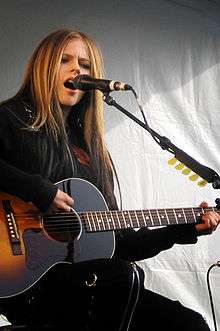

In the early 2000s, there was an astounding resurgence of interest in pop rock and power pop. This was kickstarted in the year 2000 with the success of Blink-182's song "All the Small Things" and Nine Days's song "Absolutely (Story of a Girl)", both of which peaked at #6 on the Billboard Hot 100. The trend kicked off the brief musical careers of Ryan Cabrera, Ashley Parker Angel, Teddy Geiger, Evan and Jaron, The Click Five, Jet, and Snow Patrol throughout the early and mid 2000s. This also paved the way for a second wave of pop punk bands such as Good Charlotte, New Found Glory, and Sum 41, who made use of humor in their videos and had a radio-friendly tone to their music, while retaining the speed, attitude and even the look of 1970s punk.[17] Later pop-punk bands such as Simple Plan, The All-American Rejects and Fall Out Boy had a sound that had been described as closer to late 1970s and early 1980s hardcore, with similarities to the band Cheap Trick, while still achieving considerable commercial success. In addition, some of the most successful pop-punk bands of the 1990s, such as Green Day, Blink-182, Weezer and The Offspring continued their success during the early 2000s.

In the early 2000s the power pop and pop rock trend also spread to female musicians. Michelle Branch became successful in 2001 with her song "Everywhere". Her success continued with her second album singles "Are You Happy Now? and "Breathe". Kelly Clarkson was also another prominent female artist of this movement, rivaling the success of Avril Lavigne. The first winner on the hit reality TV show " American Idol", Clarkson started off her musical career with Contemporary R&B hit songs such as "A Moment Like This" and "Miss Independent" and catapulted to cultural icon status in the mid 2000s with aggressive songs such as "Since U Been Gone" and "Behind These Hazel Eyes". Clarkson strayed away from this sound in the late 2000s, but continued to make pop rock hits. Other female pop rock and power pop artists who experienced Top 40 success in the 2000s included Alanis Morissette, Liz Phair, Ashlee Simpson, and Stacy Orrico.
Pop punk
After the breakthrough of punk rock in the 1990s, by the 2000s the genre had evolved more into pop punk due to major label records taking interest and signing on bands such as Blink-182. Green Day kick-started the 2000s with the release of their sixth studio album Warning in 2000 to lukewarm success. The following year, Blink-182 released their fourth studio album Take Off Your Pants And Jacket in 2001 which went on to sell 14 million copies worldwide. It was a commercial and critical success, debuting at number one on the Billboard 200 within its first week of release and securing the status of the pop punk trio as one of biggest bands of the genre. Also in that year, Canadian band Sum 41 released their debut album All Killer, No Filler, which went platinum in the United States. The second-wave bands dominated the pop punk genre in the early years with bands like Good Charlotte, New Found Glory, Simple Plan and Sum 41 receiving platinum status and gaining a large fan bases worldwide. In 2002, Avril Lavigne became popular in the pop punk scene thanks to her pop punk based sound, and was arguably the most prominent artist to take this new direction in pop music, with hits such as "Complicated" and "Sk8er Boi". In 2003, Blink-182 released their untitled album blink-182, which demonstrated a darker and more mature tone than previous albums. This was mainly due to the side-project Box Car Racer. Even so, the album was yet another commercial and critical success. It was to be their last album released before taking an indefinite hiatus in 2005. The band would reunite four years later. After their 1994 breakthrough, Green Day's fame was fading, mainly due to rising popularity of other bands like Good Charlotte and Sum 41. Realising this, they retreated to the studio and produced their seventh studio album American Idiot released in 2004. It saw a significant sales boost, selling 14 million copies worldwide. Fall Out Boy's From Under The Cork Tree gained commercial success in 2005 and put the band on the pop punk map. The last successful pop punk album of the decade was Green Day's eighth studio album 21st Century Breakdown released in 2009 which achieved their best chart performance to date by reaching number one on the album charts of various countries, including the United States Billboard 200, the European Top 100 Albums, and the United Kingdom Albums Chart.
Post-grunge

Post-grunge continued to be popular in the 2000s, with the genre reaching its peak in the early years of the decade. Artists include Foo Fighters, Creed, Nickelback, Lifehouse, Hoobastank, 3 Doors Down, Puddle of Mudd, Our Lady Peace, Switchfoot, Silverchair, Shinedown, Staind, Seether, and Daughtry.[18][19][20] These bands took post-grunge into the 21st century with considerable commercial success, at times abandoning the angst and anger of the original movement for more conventional anthems, narratives, ballads and romantic songs.
Nu metal
During the early 2000s, a new wave of metal began with interest in the newly emerging genre nu metal and genres of a similar style such as rap metal and the later mainstream success rap rock. The popularity of nu metal music carried over from the late 1990s, where it was introduced by early work from bands such as Korn, Deftones, Limp Bizkit, Slipknot and Coal Chamber, into the early 2000s with the similar genre, rap rock, bringing in a wave of monster-hit artists such as System of a Down, Evanescence, Staind, Papa Roach, and Disturbed. The success of Korn's third studio album, Follow The Leader, brought nu metal to the mainstream. Linkin Park's debut album Hybrid Theory, released in 2000, sold over 24 million copies worldwide. In 2004, nu metal lost popularity. Since then, many bands have changed to other genres of music, such as post-grunge (Staind), heavy metal (Slipknot, Disturbed, Drowning Pool) and alternative rock (Linkin Park, Papa Roach).
Metalcore
By 2004, the up-and-coming genre metalcore was dominated by bands such as Killswitch Engage, Underoath, Bullet for My Valentine, Trivium, and most successfully Avenged Sevenfold, all of whom releasing successful albums. The rise of metalcore led to increased popularity and exposure of nearly every other subgenre of heavy metal including death metal, black metal, and thrash. In 2002, heavy metal saw a new subgenre called deathcore, which would gain moderate success from 2005 to present day.
Hard rock/Heavy metal
AC/DC released Stiff Upper Lip in 2000 and Black Ice in 2008. Guns N' Roses released the long-awaited Chinese Democracy in 2008 after over a decade of work by Axl Rose. Metallica released two albums in the 2000s, St. Anger in 2003 and Death Magnetic in 2008. Aerosmith released the platinum-selling Just Push Play in 2001 followed by the blues-infused Honkin' on Bobo in 2004; the band also toured every year of the decade except 2008. Bon Jovi released five albums during the decade: Crush (2000), Bounce (2002), Have a Nice Day (2005), Lost Highway (2007), and The Circle (2009). Crush fared best, going double platinum, and spawning the hit "It's My Life", while Have a Nice Day and Lost Highway also launched Top 40 singles, went platinum, and saw the band mix hard rock with country. Bon Jovi's Lost Highway Tour was the highest-grossing tour of 2008. Def Leppard released 2 studio, 2 compilations and 1 cover album in the 2000s. Scorpions released 2 albums. System of a Down rose to popularity with their breakthrough album Toxicity in 2001 and would go on to sell 40 million albums by the end of the decade.
Emo
Emo broke into mainstream culture in the early 2000s with the platinum-selling success of Jimmy Eat World's Bleed American. The new emo had a far greater appeal amongst adolescents than its earlier incarnations.[21] At the same time, use of the term "emo" expanded beyond the music world, becoming associated with fashion, hairstyle, and other aesthetic attributes of culture.[22] Later in the decade, the term 'emo' was applied by critics and journalists to a variety of artists, including multi-platinum acts such as Fall Out Boy[23] and My Chemical Romance[24] and disparate groups such as Paramore[23] and Panic! at the Disco,[25] even when they protest the label. Despite its success, the emo genre never quite surpassed post-grunge in popularity during the 2000s.[26]
Garage rock, post-punk and new wave revival
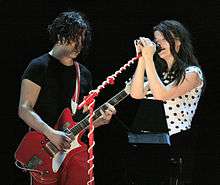
In the early 2000s, a new group of bands emerged into the mainstream which drew primary inspiration from post-punk and new wave and were variously characterised as part of a garage rock, post-punk or new wave revival.[27][28][29][30] Because the bands came from across the globe, cited diverse influences (from traditional blues, through new wave to grunge), and adopted differing styles of dress, their unity as a genre has been disputed.[31] There had been attempts to revive garage rock and elements of punk in the 1980s and 1990s and by 2000 scenes had grown up in several countries.[32] The Detroit rock scene included The Von Bondies, Electric Six, The Dirtbombs and The Detroit Cobras[33] and that of New York which included Radio 4, Yeah Yeah Yeahs and The Rapture.[34] Social networking sites such as MySpace and Purevolume enabled amateur artists to promote their music, and thanks to the internet, many underground unsigned artists become discovered and well-known amongst alternative subcultures. The revival hit a peak in 2003–04.[35] Franz Ferdinand from Scotland, also became popular with their debut album in 2004. Though drawing on an indie sound, none of the groups were derivative in a way that could be described as retro.[36] In 2004, Las Vegas-based alternative rock band The Killers released their successful debut album Hot Fuss, spawning hits like "Mr. Brightside" and "All These Things That I've Done". New York-based act The Bravery became popular the following year.[29]
Three of the most successful bands from these scenes were The Strokes, who emerged from the New York club scene with their début album Is This It (2001); The White Stripes, from Detroit, with their third album White Blood Cells (2001); and Interpol from New York, with their debut album Turn On the Bright Lights (2002).[37] They were christened by the media as the "The" bands, and dubbed "The saviours of rock 'n' roll", because of their connections with the indie rock underground, leading to accusations of hype. Other popular "The" bands were The Hives, The Vines, and The Darkness; as well as Jet, whose 2003 smash-hit "Are You Gonna Be My Girl" catupulted to the top of the charts and was frequently used in commercials primarily for music products such as the Apple iPod. Canadian punk band, Sum 41 poked fun at the start of the "The" band craze in their music video for "Still Waiting" in 2003 off the album Does This Look Infected? (2002). Will Sasso makes a cameo in the video, coining the band as "The Sums".[38][39]
Indie rock
During the mid-2000s, bands such as Modest Mouse, Death Cab for Cutie and Arcade Fire released indie rock albums that broke into the mainstream and gave indie rock recognition. The late 2000s also saw more indie rock bands such as MGMT, Spoon, Interpol, Tegan and Sara, Wilco, The Decemberists, The White Stripes, The Strokes, Animal Collective, Bright Eyes, Rilo Kiley, She & Him, The New Pornographers, Feist, Cat Power, Grizzly Bear, Arcade Fire, The Shins and Vampire Weekend gain popularity around the world, including in the United States, thanks to the rise of independent internet music blogs. The rising popularity of Internet radio also contributed to high album sales for Indie rock bands, despite little to no mainstream radio play. By the end of the decade several of these bands released albums that topped the Billboard 200. This trend has been viewed as heralding a new era for rock in the wake of an era of pop dominance by the likes of Lady Gaga, and Katy Perry.[40]
Pop
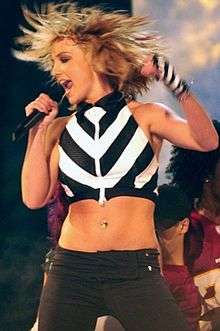
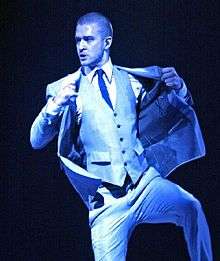
Teen pop continued to be an extremely popular genre in the early 2000s with success of teenage pop singers Britney Spears and Christina Aguilera. Spears' "Oops!...I Did It Again" and Aguilera's "Come On Over Baby (All I Want Is You)" became huge hits in the year 2000. By 2001, however, the teen-pop trend dissolved dramatically due to modern R&B and hip-hop influenced music that later dominated throughout the middle of the decade. Spears' 2001 album Britney and Aguilera's 2002 album Stripped are examples of teen pop artists transitioning from teen pop to more grown-up, modern R&B influenced records.
Boy bands maintained their popularity during the beginning of the decade, but their popularity also faded after 9/11, with the exception of Backstreet Boys, who continued their popularity post-2005, (after a short hiatus between 2002 and 2004). As the typical "boy band" sound was no longer mainstream, they began to transition to more of an adult contemporary, soft-rock and ballad styles of music for the remainder of the decade. By 2002, records by boy bands were very sparse on the Billboard Hot 100, and some members of boy bands left to pursue other projects and solo endeavors, such as Jesse McCartney from Dream Street and most successfully Justin Timberlake from 'N Sync, whose foray into Blue-eyed soul R&B/Pop spawned a successful solo career. A new strain of boy bands, such as V Factory, Varsity Fanclub, Click 5ive, NLT, and the Jonas Brothers, emerged at the end of the decade, but this new generation of boy bands did not reach the glamor and success of those of the 1990s and early 2000s. Girl groups maintained a steady popularity through the 2000s, with groups such as Destiny's Child (which disbanded in 2005) setting the fuel for the most successful girl group of the decade, the Pussycat Dolls (2003–10). Other girl groups included Danity Kane (2005–09) and Sugababes.
Pop rock artist Pink released her debut album Can't Take Me Home in 2000, including "Get the Party Started", and later, her I'm Not Dead album in which features "Stupid Girls" and "Who Knew". Her following album, Funhouse, released in 2008 also included "So What" and "Sober".
Singer Anastacia sold over 25 million albums during the 2000s and achieved worldwide commercial success with singles such as "Not That Kind", "I'm Outta Love", "Paid My Dues", One Day in Your Life and "Left Outside Alone". She was highly successful in Europe, Australia, New Zealand, Asia, South Africa and South America, but had only minor success in her native United States. She is one of the fastest and biggest-selling artists of the new millennium.
In 2001, triple-threat entertainer Jennifer Lopez debuted at number one on the U.S. Billboard 200 and the Top R&B/Hip-Hop Albums chart with her J.Lo album and in addition her film, The Wedding Planner, opened at number one at the box office at the same time making her the first actress and singer in history to have both a film and an album at number one in the same week.
Artists such as Janet Jackson, Anastacia, Kylie Minogue, Mariah Carey, and Nelly Furtado experienced revived success. Justin Timberlake shot to stardom with his debut solo album, Justified (2002). In 2005, Cher ended her 3-year-long "Farewell Tour" which became the highest grossing female and solo tour at that time. Madonna enjoyed success throughout the decade. Her albums Music (2000) and Confessions on a Dance Floor (2005) are among the best-selling of the decade. Both were universally acclaimed by critics. The first was also nominated for 5 Grammy Award while the second won one. Madonna also had a four highly successful tours in the 2000s. The Re-Invention Tour which grossed $125 million in just 56 shows making it the highest grossing of 2004, The Confessions Tour went on to gross over $190 million in 60 shows becoming the highest grossing tour by a female ever. Her final tour in 2008/09 was Sticky and Sweet Tour which become the highest grossing female tour and the highest grossing solo tour of all-time making $408 million in 85 shows.
Justin Timberlake released his sophomore studio album FutureSex/LoveSounds in 2006, producing the chart-topping singles "SexyBack", "My Love", and "What Goes Around... Comes Around", and winning four Grammy Awards for the record.
Lady Gaga took the later part of the decade by storm and revived the electronic influence of pop music that had not been prominent since 2000. Her debut album, The Fame (2008), reached number-one in Canada, Austria, Germany, United Kingdom and Ireland and topped the Billboard Top Electronic Albums chart. Its first two singles, "Just Dance" and "Poker Face", became international number-one hits, topping the Hot 100 in the United States as well as other countries. The album later earned a total of six Grammy Award nominations and won awards for Best Electronic/Dance Album and Best Dance Recording. By the fourth quarter of 2009 she had released her second studio album The Fame Monster, with the global chart-topping lead single "Bad Romance".
In 2001 Michael Jackson, one of popular music's most successful artists of all-times, released his final studio album Invincible, though it did not receive a lot of exposure compared to previous releases. Michael Jackson died in June 2009, creating the largest public mourning since the death of Diana, Princess of Wales in 1997.[43][44][45]

Children's music rose significantly in sales, especially with Disney (The Cheetah Girls, High School Musical, Hannah Montana: The Movie, and The Jonas Brothers among others). All The Cheetah Girls, High School Musical and Hannah Montana albums were among the best-sellers of 2006 and 2007 and reached the number 1 position, left many artists produced by Disney in the 2000s, The Cheetah Girls, Hilary Duff, Selena Gomez & the Scene, Miley Cyrus, Demi Lovato, Jonas Brothers, Raven-Symoné, the best-selling artists of the decade.
The musical style of the 1980s influenced pop music to some extent in the later stages of the decade, especially around late 2009, as seen in Rihanna's hit "SOS" (a sampling of Soft Cell's "Tainted Love"), Lumidee's "She's Like The Wind" and Flo Rida's "Right Round", a reworking of the Dead or Alive hit "You Spin Me Right Round". Other hits include Aaron Carter's cover of Bow Wow Wow's "I Want Candy", and Britney Spears' covers of "My Prerogative" and "I Love Rock 'n' Roll". Pop rock groups such as Metro Station and Owl City also displayed 1980s influences. Beyoncé's hit "Sweet Dreams" was not a direct sampling of an 1980s pop hit but Anne Hagerty of Billboard magazine was quoted saying, "this track will fit right on a Michael Jackson or Madonna instrumental." Alien Ant Farm successfully covered Michael Jackson's "Smooth Criminal", and Fall Out Boy came out with their own cover of "Beat It", later on. Bowling for Soup also had a hit with "1985", a nostalgic ode to the 1980s.
1980s pop star Cyndi Lauper released several albums, experimenting with different styles, like adult contemporary, pop, pop rock, electronic music and blues. These were critically acclaimed and received several nominations for Grammy Award, and Lauper saw significant sales throughout the decade.
Adult contemporary

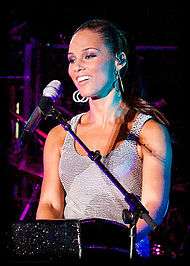
The radio format called Adult contemporary music (primarily "soft rock" or "lite-rock"), began to somewhat decrease in popularity starting in the late 1990s (due to the increasing popularity of Top 40 music) into January 2000 until September 11, 2001. After 9/11, popularity for Adult Contemporary Music (as well as Contemporary Christian Music crossovers) increased tri-fold during the grieving process, when the 25–44 Conservative Female Demographic favoured listening to songs with appropriate, positive and uplifting lyrics containing love and hope. Upon the eventual return to normalcy after 9/11, the popularity of Adult Contemporary music held steady until about 2003, when Billboard began to change their chart formats. This led to Adult Contemporary stations to program their music "not-as-soft" or "cheesy" as they used to, and ended up substituting the words "soft-rock" with "lite-rock", which has a more modern-edged connotation. Yet, AC stations remained careful to not cross the Adult Top 40 format line. Because of all these changes, AC Stations slowly increased in popularity.
In the late 2000s, artists like Coldplay, Daughtry and Gavin Rossdale were finding more success crossing over onto the Adult Contemporary charts.
On the female side, artists like Sara Bareilles, Colbie Caillat, Diana Krall, Norah Jones, Kelly Clarkson, Alicia Keys, and Leona Lewis continued to find crossover success on the Adult Contemporary charts as well. AC veterans such as Celine Dion, Rod Stewart, Phil Collins, The Eagles, Cyndi Lauper, Alanis Morissette and Sheryl Crow continued to release music only on the Adult Contemporary formats. There are three songs which experienced longevity atop the chart, "Love Song" by Sara Bareilles, "Bubbly" by Colbie Caillat, and "Breakaway" from Kelly Clarkson spent a longevity 20 weeks atop the chart.
Alicia Keys is considered the most successful R&B singer of the decade with 30 million records sold worldwide. Keys scored hits in the U.S. charts with seven songs on the Hot R&B/Hip-Hop Songs and four songs on the Billboard 100. She shares a record with Britney Spears, being the only two female singers to have their first four albums debuting in first place in the chart Billboard Hot 200. Beyoncé would become the third female singer to accomplish this feat in 2011.[46]
Norah Jones is considered the greatest Jazz singer of the decade with 37 million records worldwide. She broke worldwide in 2003, a year after releasing her debut album Come Away With Me with 10 million copies sold in United States of America and 20 million sold worldwide. Jones continued her success with her second album becoming the biggest selling album in one week with 1,900,000 million copies sold, going on to release two more bestselling albums in the 2000s, and having 3 albums debut in the Billboard 200 and winning eight Grammys with her debut album and 12 Grammys in total during the decade.
Contemporary R&B
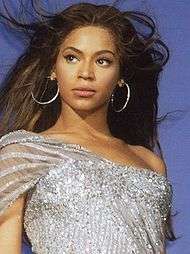
The continued popularity of contemporary R&B was seen during this decade in the global success of established artists such as Beyoncé with the help of Destiny's Child, Mariah Carey, Jennifer Lopez, Mary J. Blige and Usher, whose careers began in the 1990s and continued in the dawn of the new millennium. The year 2001, in particular its summer, has been described as a golden age for contemporary R&B and urban soul music, with artists such as Janet Jackson, Jill Scott, Mariah Carey and Destiny's Child, who paved the way for Alicia Keys, Blu Cantrell, and the revival of Aaliyah.[47][48]
Janet Jackson was awarded the American Music Awards' Award of Merit in March 2001 for "her finely crafted, critically acclaimed and socially conscious, multi-platinum albums."[49] She became the inaugural honoree of the "mtvICON" award, "an annual recognition of artists who have made significant contributions to music, music video and pop culture while tremendously impacting the MTV generation."[50] Jackson's seventh album, All for You, was released in April 2001, debuting at number one on the Billboard 200.[51] Selling 605,000 copies, All for You had the highest first-week sales total of her career.[52] Stephen Thomas Erlewine of Allmusic stated "[Jackson's] created a record that's luxurious and sensual, spreading leisurely over its 70 minutes, luring you in even when you know better", and Jon Pareles of The New York Times commented, "[a]s other rhythm and blues strips down to match the angularity of hip-hop, Ms. Jackson luxuriates in textures as dizzying as a new infatuation."[53][54]
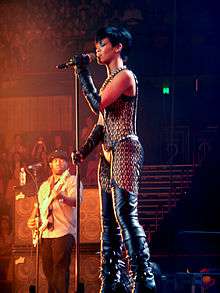
The album's title-track, "All for You", debuted on the Hot 100 at number fourteen, the highest debut ever for a single that was not commercially available.[55] Teri VanHorn of MTV dubbed Jackson "Queen of Radio" as the single made radio airplay history, "[being] added to every pop, rhythmic and urban radio station that reports to the national trade magazine Radio & Records" in its first week.[55] The single peaked at number one, where it topped the Hot 100 for seven weeks.[56] It received the 2001 Grammy Award for Best Dance Recording.[57] The second single, "Someone to Call My Lover", which contained a heavy guitar loop of America's "Ventura Highway", peaked at number three on the Hot 100.[58] All for You was certified double platinum by the RIAA and sold more than nine million copies worldwide.[59]
Beyoncé was ranked the 4th Artist of the 2000s decade by Billboard,[60] and was listed the most successful female artist of the 2000s, as well as the top radio artist of the 2000s.[61] The Recording Industry Association of America (RIAA), also recognized Knowles as the top certified artist of the 2000s.[62][63] As of 2014, Knowles has sold more than 13 million albums and 30 million singles in the United States.
Beyoncé, Michelle Williams and Kelly Rowland, better known as Destiny's Child is the most successful female R&B group of all time, selling over 50 million records worldwide during the 2000s. The group has many chart topping singles worldwide, such as "Survivor", "Say My Name", "Bootylicious", "Independent Women Part 1" and "Jumpin' Jumpin'".
.jpg)
Other emerging acts from the early 2000s include Ashanti, Rihanna, Trey Songz, Ne-Yo, Chris Brown, Bobby V, Keyshia Cole, Pretty Ricky, B2K, Jaheim, Musiq Soulchild, Rueben Studdard, Fantasia, and Ciara.[64]
Singer Mary J. Blige topped the Billboard Hot 100 in 2001 with her smash single, Family Affair, taken from hit album No More Drama. She scored a big hit with, "Be Without You", which peaked at #3 on the Hot 100. During the 2000s decade, Mary released five platinum albums. Billboard Magazine ranked Blige as the most successful female R&B artist of the past 25 years. The magazine also lists "Be Without You" as the top R&B song of the 2000s, as it spent an unparalleled 15 weeks atop the Hot R&B/Hip-Hop Songs chart.
R&B artist Robin Thicke topped the R&B Charts with his hit single "Lost Without U". He was the first white artist to top these charts since George Michael. His album The Evolution of Robin Thicke went on to be certified platinum by the RIAA.
Musical artist Usher was named the number one Hot 100 artist of the 2000s decade and Billboard named him the second most successful artist of the 2000s decade.[65] Usher released the album Confessions which went on to become the best-selling album of 2004[66] and the second best-selling album of the 2000s. He also had the overall total most number #1 singles of the decade with 7 going top of the chart. Confessions is now certified Diamond by the RIAA.[67]
Country
Country music sales continued to rise, in the Billboard 200 all-genre album chart frequently had albums recorded by country music artists listed; several of those titles were certified double platinum or better, indicating the genre continued to have a strong niche in the music industry.
One of the most successful new artists of the decade was Carrie Underwood. In 2005, the Checotah, Oklahoma native became the first American Idol winner to record primarily country music, instead of pop, rap or rhythm and blues. By the end of the decade, Underwood had amassed eight No. 1 songs on the Billboard Hot Country Songs chart, along with numerous awards from the Country Music Association, Academy of Country Music and others.
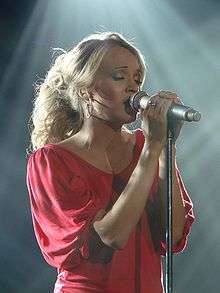
Country pop, a subgenre which has its roots in the Nashville Sound of the late 1950s-early 1960s, continued to flourish in popularity. The most prominent act was Shania Twain, with her album Up!, released in 2002, Other top performers in the genre included Dixie Chicks, Lonestar, Martina McBride, Tim McGraw, Faith Hill, Keith Urban and Rascal Flatts. In the middle of the decade, an informal group of singers and songwriters called the MuzikMafia formed to promote their mesh of honky-tonk and outlaw brand of country music; the most prominent members were "Big" Kenny Alphin and John Rich (of the duo Big & Rich) and Gretchen Wilson, who enjoyed success in the middle part of the decade.
Many non-country artists enjoyed success in the country music during the 2000s. The most successful of these artists has been former Hootie & the Blowfish lead singer Darius Rucker, who had three No. 1 hits in 2008–09: "Don't Think I Don't Think About It", "It Won't Be Like This for Long" and "Alright." The Eagles, a California-based country-rock group, had their first major success on the Hot Country Songs chart in more than 30 years in 2007–08 with the songs "How Long" and "Busy Being Fabulous." Other non-country artists who had success in the genre were Kid Rock, Sheryl Crow, Robert Plant, Jewel, Jessica Simpson, Bon Jovi and Miley Cyrus.
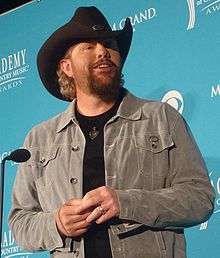
In the late 2000s, teenager Taylor Swift became the first country artist to enjoy widespread mainstream popularity since the 1980s, when artists including Ronnie Milsap, Dolly Parton, Eddie Rabbitt and Kenny Rogers regularly recorded music that appealed to both country and pop audiences. Two of Swift's songs – "Love Story" and "You Belong With Me" – both reached the top 5 of the Billboard Hot 100 (and No. 1 on several of the Hot 100s component charts) after topping the Hot Country Songs chart. At the 2009 MTV Video Music Awards, Swift became the first country artist to win a VMA award when she won in the Female Best Video category for "You Belong With Me".
Not everyone celebrated the success of artists such as Underwood and Swift, reflecting the continued discontent and debate over what constituted "real" country music, a debate that had been on and off since the 1970s. Despite the fact that country music songs had long been crossing over to pop radio (and charting since the start of the Billboard charts in 1940), some critics continued to state opinions that the pop-oriented sound was little more than repackaged pop music. In 2009, legendary country music artist George Jones proclaimed that "they've (the new artists) stolen our identity. ... They had to use something that was established already, and that's traditional country music. So what they need to do really, I think, is find their own title, because they’re definitely not traditional country music."[68] In addition, several forums, including the classic country-oriented Pure Country Music Web site, regularly included posts that were openly critical of artists such as Swift and Rascal Flatts.[69] Songs such as "Murder on Music Row" (by George Strait and Alan Jackson) and "Too Country" (by Brad Paisley) gained widespread acceptance and radio airplay, despite criticism in the lyrics over the eschewing of traditional sounds by radio programmers.
However, traditional country music retained a large following during the decade, thanks to the ongoing successes of veteran artists such as Strait, Jackson, Reba McEntire, Brooks & Dunn, Toby Keith and Kenny Chesney, and newer artists such as Paisley, Blake Shelton and Billy Currington. Rogers, Parton and Willie Nelson, all artists who had No. 1 country hits as far back as the early 1970s, all had No. 1 songs during the 2000s decade – either as soloists (Rogers), as part of one-time duo pairings (Nelson) or as featured background vocalists (Parton). McEntire's success came with two albums hitting No. 1 on the all-genre Billboard 200 albums chart (Reba Duets and Keep On Loving You ), and at the end of the decade had her biggest hit of her career ("Consider Me Gone"). In addition, veteran songwriters such as Bill Anderson and Bobby Braddock also enjoyed continued success with newly written songs. Late in the decade, newcomers such as Jamey Johnson and Miranda Lambert were widely hailed for their songwriting and performance talents.
The legendary group Alabama retired from touring in 2004 after nearly a quarter century of mainstream success, primarily during the 1980s and 1990s. Its band members – cousins Randy Owen, Teddy Gentry and Jeff Cook; and drummer Mark Herndon – remained active performers and recorded a successful series of albums containing gospel and traditional old-time songs.
Many legendary country music figures died during the decade. Some of the more prominent names included Waylon Jennings, June Carter Cash, Johnny Cash, Buck Owens, Hank Thompson, Porter Wagoner, and Eddy Arnold.
Electronic music
In Europe, Trance music was popular in the early 2000s, but this style diminished as the decade wore on. Hard House became the next big craze after trance in 2001, with a certain amount of cross-over between the two genres (in some cases creating Hard Trance tracks). As a kind of backlash, ambient, Chillout music achieved mainstream popularity in the early 2000s, with a successful market of chillout compilations and the genre even making it into television commercials and soundtracks.
Disco house and funky house, popular in the late 1990s, continued to be successful through to the mid-2000s, before the sound of electro house developed around 2006. The electro sound began to merge with other genres such as Hip Hop as the decade drew to a close.
In 2007 and later, dance music started gaining popularity in North America with dance-pop hits by artists such as the pop singer Rihanna's song "Don't Stop the Music" and "Disturbia". Hilary Duff in her album Dignity has changed her style from pop rock to the more contemporary electropop, to go with the current trends. In 2008 and 2009 electropop and Nu-disco make an increase in popularity in North America and replaced hip-hop and R&B as the dominant genres of music with artists such as Britney Spears, Beyoncé, and Lady Gaga bringing this style to great popularity towards the end of the decade with their hits such as Britney's "Womanizer", Beyonce's Single Ladies (Put a Ring on It) and Gaga's Poker Face. The first traces of electropop has taken place in late 2006 with artists such as hellogoodbye and Timbaland. Furthermore, Madonna's singles such as "Hung Up" (#1 in 45 countries) and "4 Minutes" (#1 in 32 countries) become huge dance hits. (See hip hop, urban pop and R&B above for more information.) Pop duo Aly & A.J. explored electropop and 1980s new wave influences in their second album "Insomniatic". In addition, some of the most successful Electronica American artists and DJs in the 1990s, such as Moby and The Crystal Method, also continued their success during the 2000s.
Jazz

In the 2000s, straight-ahead jazz continued to appeal to a core group of listeners. Well-established jazz musicians, such as Dave Brubeck, Wynton Marsalis, Sonny Rollins, Wayne Shorter and Jessica Williams, continue to perform and record. In the 2000s, a number of young musicians emerged, including the pianist Jason Moran, vibraphonist Stefon Harris, trumpeter Roy Hargrove, and bassist Christian McBride.
In addition, a number of new vocalists have achieved popularity with a mix of traditional jazz and pop/rock forms, such as Diana Krall, Norah Jones, Cassandra Wilson, Kurt Elling, and Jamie Cullum. Norah Jones and Diana Krall, due to their massive international success during the 2000s are considered the first and second most successful female jazz singers of the decade, respectively.
Reggae
- Dancehall
The early 2000s saw the success of newer charting acts such as Elephant Man and Sean Paul, who has achieved mainstream success in the US and has produced several top 10 Billboard hits, including "Gimme the Light", "We Be Burnin'", "Give It Up To Me", and "Break It Off" (a duet with Rihanna). He has also had several No. 1 singles, "Get Busy", "Temperature" and "Baby Boy" (a duet with Beyoncé).
- Reggaeton
Reggaeton gained mainstream exposure and massive popularity in North America during the mid-2000s. Reggaeton blends West-Indian music influences of reggae and dancehall with those of Latin America, such as bomba, plena, salsa, merengue, latin pop, cumbia and bachata as well as that of hip hop, contemporary R&B, and electronica. The influence of this genre has spread to the wider Latino communities in the United States, as well as the Latin American audience Shakira is the best Latin artist she have sold more than 100 million copies in the 21st century.
Christian Music
Christian music continued to gain popularity after the success in the 1990s with acts such as Jars of Clay and Audio Adrenaline. Bands such as Relient K whose work in the pop punk/ pop rock scene earned them 3 albums certified gold The Anatomy of the Tongue in Cheek, Two Lefts Don't Make a Right...but Three Do, and MMHMM, Also being nominated for a Grammy. Skillet being nominated for a Grammy for two albums Collide and Comatose. Also gaining success with Awake getting Platinum and Comatose selling Gold.
Billboard Artist of the Decade
On December 11, 2009, Billboard Magazine named Rapper Eminem as the best Artist of the Decade for the 2000s. He joins the list with Elvis Presley, The Beatles, Elton John, Michael Jackson, and Mariah Carey, who have also been awarded with this honor in their respective decades.
Europe
Rock


Following after the success of Radiohead and The Verve in the 1990s, Post-Britpop act Coldplay saw major success in European album charts during the decade. British Indie rock and indie pop returned to popularity in the mid-late 2000s with artists such as Arctic Monkeys, Franz Ferdinand, Belle and Sebastian, Amy Winehouse, Kaiser Chiefs, Keane, The Libertines, Editors, Lily Allen, Kate Nash, Florence And The Machine, and The Ting Tings achieving substantial chart success. Post punk bands such as Bloc Party, Foals and Editors also saw some popularity. Britpop act Oasis also remained popular in the 2000s (decade), spawning four number one albums in the UK until the disbandment of the group in autumn 2009.
U2 continued their popularity into the 2000s, releasing three critically acclaimed albums, and were credited with influencing many prominent acts of the decade such as Coldplay and Muse.
In the early and mid-2000s, British Indie rock groups such as The Libertines, Arctic Monkeys, Bloc Party and Kaiser Chiefs witnessed commercial and chart success not seen by guitar music since Britpop in the 1990s.[70] Regional indie rock scenes such as New Yorkshire also appeared at this point in the decade. Indie music itself increased in popularity due to the increased commercialization of alternative, and major labels begin marketing indie bands with mainstream appeal. American indie/rock band The Killers also became very popular in Britain with their singles Mr. Brightside, When You Were Young and Smile Like You Mean It.
Radiohead enjoyed further success in the 2000s, moving away from their experimental sound of the Kid A/Amnesiac era to a more "typical" Alternative rock sound. Coldplay also enjoyed success with four number one albums and a U.S. No. 1 single with Viva la Vida, the first English band to do so since The Beatles. Muse saw a similar level of commercial acclaim, with the rock trio releasing three chart-topping albums.
The late 2000s (entering into the early 2010s) saw the revival and influence of synthpop music, also known as 'new urban' pop. Notable acts include Hot Chip, Junior Boys, Little Boots and La Roux.
The era also saw solo success for singer/songwriters, including David Gray, Dido,[71] James Blunt, James Morrison,[72] KT Tunstall and Amy Macdonald.[73]
Hip hop

The eponymous debut album of Gorillaz, created by Damon Albarn in 2001, sold over seven million copies and earned them an entry in the Guinness Book of World Records as the Most Successful Virtual Band.[74]
Grime, a distinctly British version of hip hop, became popular, with notable artists such as Dizzee Rascal and Tinchy Stryder achieving success.[75]
Pop
Girl groups Sugababes, Girls Aloud and t.A.T.u. spanned successful careers throughout most of the decade, whilst 1990s act Spice Girls announced their breakup in 2001 and later reformed in 2007. S Club 7 broke up in 2003, after 5 years of considerable chart success.
.jpg)
Irish singer Enya continued to enjoy steady success during the 2000s; her 2000 album A Day Without Rain sold 15 million copies[76] and she was named the world's best selling female artist of 2001.[77]
Audience-voted reality talent shows became very popular with UK TV audiences in the 2000s. Such programmes included Popstars, Pop Idol, Fame Academy and The X Factor, and many contestants progressed onto mainstream chart success. The Eurovision Song Contest also retained its important status within European music.
1980s female pop stars Madonna and Kylie Minogue enjoyed a large presence on the European music scene, both having numerous hits in the 2000s including "Music", "Hollywood", "Hung Up"and "Celebration" for Madonna and "Spinning Around", "Can't Get You Out of My Head", "Slow" and "In My Arms" for Kylie. Britney Spears retained a huge impact throughout the continent and was one of the most successful artists of the decade in that region.
In 2004, Moldovan pop music trio O-Zone's hit single "Dragostea din tei" witnessed major European and international success. Later in the decade, Romanian pop/dance singer Inna spawned a European hit single with "Hot" and became the first Romanian internationally known female star in modern history.
When American boyband Backstreet Boys returned to the music scene in 2005 with a more adult rock sound, some of their 1990s contemporaries from Europe followed. Take That reunited in 2006 without Robbie Williams and managed to recreate their earlier success. Bands such as Boyzone also experienced second-time success, whilst others of the same era such as 5ive and East 17 did not and subsequently disbanded. The Irish boy band Westlife were very successful, and emerged as the top selling British group of the decade with 44 million records sold and a number of record-breaking hit singles and albums.
Soul

British soul in the 2000s was dominated by female singers, many of them white. Joss Stone, Natasha Bedingfield, Corinne Bailey Rae, Estelle, Amy Winehouse,[78] Adele and Duffy enjoyed success in the American charts, leading to talk of a "Third British Invasion", "Female Invasion" or "British soul invasion".[79]
Also, in America Christina Aguilera released her third studio album with soul and jazz influences, Back To Basics in 2006.
Electronic music

The popularity of the Eurodance genre in the 1990s lead to the considerable popularity of the trance genre in the late 1990s and early 2000s. Popular artists of the decade included ATB, Ian Van Dahl, Dj Sammy, Alice Deejay, Fragma, Sylver, Robert Miles, Tiësto, Armin Van Buuren, Paul Oakenfold, Paul Van Dyk, WestBam and Darude.
Popular electronic artists of the decade in other electronic genres included Fatboy Slim, The Chemical Brothers, Groove Armada, Basement Jaxx, Daft Punk, Massive Attack, Röyksopp, Goldfrapp, Orbital, Propellerheads, Underworld and David Guetta.
Electro, as well as House, became mainstream in the dance music scene in the middle of the decade, replacing the mainstream of more jazzy and Latin influenced sounds from the beginning of the decade. Electro house artists such as Justice and MSTRKRFT gained popularity in clubs around the world. Dubstep and Bassline House achieve more mainstream success within the dance music scene, with artists like Skream and T2 becoming well known. Dance and eurodance singers and groups such as Kate Ryan, September, Alcazar, Basshunter, and Cascada become popular around the world during the 2000s.
Australia and New Zealand
Pop
.jpg)
The most successful Australian female artist, Kylie Minogue still had a huge presence on the Australian music scene with all four albums she released during the decade, with X being the last one, and charting at number one along with its lead single "2 Hearts" becoming her 10th Australian number 1 single.
Ex-Neighbours star, Delta Goodrem released her debut album Innocent Eyes in 2003 which became a monster smash hit – it went to No. 1 and stayed for 29 non-consecutive weeks, being certified 14x Platinum for selling over one million copies, the second most of all time in Australia.
In New Zealand, pop singer Brooke Fraser has seen large success throughout her music career with number one songs and countless New Zealand Music Awards wins. Other popular artists include, Aaradhna, Vince Harder, Anika Moa, Gin Wigmore, whose debut album Holy Smoke peaked at number one in New Zealand in 2009 and Ladyhawke, who achieved substantial international success following the release of her self-titled debut album in 2008, which peaked at number one in New Zealand and charted in the top twenty in Australia and the United Kingdom. In 2009 she received several New Zealand Music Awards and ARIA music awards and was nominated for a BRIT award in 2010.
Rock
Many new rock and alternative groups/bands form during the early years of this decade. Groups/bands such as The Vines and Jet become very popular amongst others around 2002–03, paving the way for a mass of new groups midway through the decade such as Wolfmother. Other popular artists include Powderfinger, The Vines, You Am I, Silverchair, AC/DC, The Living End, Spiderbait, Grinspoon, Kisschasy and Eskimo Joe.
Many rock artists in New Zealand were popular throughout the 2000s decade including, Evermore, The Feelers, Neil Finn, Tim Finn, and Liam Finn.
Alternative
From 2003 up until 2007 a popular American television show, The O.C., popularized many New Zealand alternative rock bands by playing their music during the years of the series run. These bands included, Evermore and Youth Group.
R&B and soul
Throughout the 2000s decade, R&B and soul music had become more popular in Australia and New Zealand. Most Australian R&B artists from the early 2000s, such as Guy Sebastian, Paulini and Ricki-Lee Coulter, were known as contestants on Australian Idol and have established themselves in the Australian music market and continued to enjoy success after the show. Sebastian's debut album Just as I Am debuted at number one on the ARIA Albums Chart and was certified six times platinum by the Australian Recording Industry Association (ARIA), becoming the highest selling album ever released by an Australian Idol contestant.[80][81][82] He also has received 14 ARIA Music Awards nominations and is the only Australian male artist in Australian music history to achieve five number one singles. Other Australian R&B/soul artists from the early 2000s include Jade MacRae, Israel Cruz, female duo Shakaya and boy band Random, who were best known for winning The X Factor (Australia) in 2005. The late 2000s saw the rise of 2009 Australian Idol winner Stan Walker and 2006 Idol runner-up Jessica Mauboy.
In New Zealand, R&B/soul groups Adeaze and Nesian Mystik have enjoyed success throughout their careers. Singer Aaradhna has released three top-ten singles "Downtime", "I Love You Too", and "They Don't Know" with rapper Savage.[83] Other R&B singers include Pieter T and Vince Harder. The late 2000s saw the rise of J.Williams and Erakah.
Hip Hop
Early into this decade, Australian Hip Hop have proved ultimate success through an Adelaide Hip-Hop trio, Hilltop Hoods. They became the first successful Australian Hip Hop outfit, followed by a Sydney Hip-Hop trio, Bliss n Eso. Each have achieved ARIA awards.
The New Zealand hip hop scene have seen the success of artists such as, Scribe, Savage, Smashproof, David Dallas, Young Sid, Nesian Mystik and P Money. In 2009 Smashproof and Gin Wigmore collaborated on the successful single Brother, which stayed at number one on the New Zealand charts for eleven weeks, breaking the 23-year-old record for longest consecutive run at number one on the charts by a local artist. The single also charted in Germany.
Latin America

Rock
During the early 2000s, Lynda Thomas had notable success as an alternative rock act around the world, including the U.S. Latin market, a success carried over since the 1990s, first as a eurodance act; she scored successful rock singles in 2000 and 2001 including "A Mil por Hora", Lo Mejor de Mi and Estoy Viva.
Pop
The Colombian Latin pop singer Shakira breakthrough at the early 2000s led to her major international success in many non-Spanish-speaking countries, especially the United States in addition to the music scene of Latin America. In 2001, and aided by heavy rotation of the music video, "Whenever, Wherever", she broke through into the English-speaking world with the release of Laundry Service, which sold over 13 million copies worldwide.[84][85] Four years later, Shakira released two album projects called Fijación Oral Vol. 1 and Oral Fixation Vol. 2. Both reinforced her success, particularly with one of the most successful song in the 21st century to date, "Hips Don't Lie" which sold over 10 million copies and downloads worldwide and hit number 1 in many countries.[86] From October–November 2009 Shakira released her latest album She Wolf worldwide.[87] Due to her massive international success during the 2000s she is considered the second most successful female Latin singer.[88] Pop rock begins to take shape in Latin music with acts such as Camila, Kany García, Jesse & Joy, Belinda Peregrin and Ha*Ash. Also, more established pop acts such as Pepe Aguilar, Alejandro Fernández, Luis Fonsi, and ex-OV7 member Kalimba would use pop rock in their repertoires. Pop-rock music hits new highs in the 2000s with acts such as Maná, Juanes, and Julieta Venegas topping the charts in several countries.
.jpg)
Reggaetón
In 2002, New York-based group Aventura would reinvent bachata, thus making it a dominant Latin genre. By 2004, reggaeton would become a staple in music with acts such as Don Omar, Daddy Yankee, Ivy Queen and Wisin & Yandel. By mid-2000s Reggaetón had replaced salsa, merengue and cumbia as the main dance genre in nightclubs for young people all over Latin America, reaching popularity in parts of Spain and Italy as well. But by the end of 2007, this craze soon declined in popularity.[89]
Salsa and merengue
Although salsa and merengue began to decline in popularity, merengue would have new life injected thanks to the subgenre known as, "merengue de calle" (or street merengue). Beginning in 2004, this subgenre combining elements of merengue, rap, and reggaeton would be popularized by Dominican acts such as Omega, Silvio Mora, El Sujeto, and Tito Swing.
Asia
With the rapid development of Asian economies during the 1990s and 2000s, the independent music industries of Asia have seen considerable growth. Asian countries like Japan and India have some of the largest music markets in the world. Supported by their own large markets, the music charts in Asia are largely dominated by local Asian artists, with very few artists from the Western world managing to break those markets.
J-pop and K-pop have become increasingly influenced by contemporary R&B, hip hop music and Eurobeat, and they have become popular all over the Far East region. Meanwhile, in the Southern Asia region, the rising independent Indian pop scene, often characterized by its fusion of Indian and non-Indian sounds, has begun to increasingly compete with the popularity of Bollywood filmi music in the region.
Japan
J-Pop continues to be in the mainstream and stays as the most popular style of music in Japan. Japanese Pop's popularity continues to expand through Asia and the rest of the world, with various Japanese artists debuting in the US. J-Pop starts to enjoy a relatively big global online fan base. It continues to influence worldwide styles of music, as Japanese culture has continuously become more popular around the world. Japan also remains as the second most powerful musical industry in the world, and the second largest music market, after the US. R&B is popular at the beginning of the era, with Hip-Hop also becoming more popular as time passes. At the end of the decade, Dance music and Techno become the most popular genres. Bubblegum pop remains popular during the entire decade.
Ayumi Hamasaki becomes one of the most popular Japanese star of the 2000s, experiencing her biggest peak at this time, becoming known as "The Empress of Japanese Pop", and greatly influencing music, fashion and pop culture. Ken Hirai becomes the most popular male solo artist. 1990s divas like Namie Amuro, Misia, and Hikaru Utada also remain extremely popular during this era, with the former having a second popularity boom in 2008. Starlet Kumi Koda also becomes insanely popular in this era, thanks to her fresh dance style and provocative dance moves. Boy bands are the most popular musical format at the moment, with girl bands like Morning Musume (very popular in the past) experiencing a decline in popularity. While Johnny's boy bands become very popular, other vocal groups like Exile and Tohoshinki also gained popularity and pop/rock bands like Mr. Children, Tokio and Glay remained popular. Duets also become popular, such as M-Flo. Like all countries, English pop music popularity expands at a very high rate with popular U.S artist receiving success such as Backstreet Boys and Britney Spears who become the most popular and two of the most successful non-Japanese artists.
India
The Indian music industry was previously dominated by the Filmi music of Bollywood for much of the late 20th century. The 2000s saw an increasing popularity of independent Indian pop music that could compete with Bollywood film music. Indian pop music began distinguishing itself from mainstream Bollywood music with its fusion of Indian and non-Indian sounds, which later had on influence on Bollywood music itself. Indian pop has itself been partly influenced by the Asian Underground scene emerging in the United Kingdom among British Asian artists such as Bally Sagoo, Apache Indian, Panjabi MC, Raghav and the Rishi Rich Project (featuring Rishi Rich, Jay Sean and Juggy D). India has one of the largest music markets in the world, though like other developing nations, suffers from high levels of piracy.
Indian music has also had an increasing influence on popular music in the Western world. The music of South Asia has influenced Europe's pop mainstream as acts like Björk, Bananarama, Erasure, and Siouxsie and the Banshees all released singles or remixes featuring South Asian instrumentation. Indian music has also influenced mainstream American hip hop, R&B and urban music in the 2000s, including artists/producers such as Timbaland, Jay-Z, Dr. Dre, Truth Hurts, The Black Eyed Peas, Missy Elliott and Britney Spears. According to DJ Green Lantern, "Indian beats have now become a fixture on the R&B scene".[90] Several Hollywood musical films such as Moulin Rouge! have incorporated Bollywood songs, while several Indian music composers have gained international fame, particularly A. R. Rahman who, having sold over 300 million records worldwide, is one of the best-selling music artists of all time.[91][92] M.I.A., a British-born Sri Lankan electronic artist incorporates Bollywood songs in her music.
Middle East and Africa
Music charts in the Middle East are largely dominated by local [Arabic-language] artists, with an equivalent population of Western world artists as well. The music industry within the Middle East and Africa is international and diverse.
See also
References
- 1 2 Reyonolds, Simon (July 15, 2011). "The Songs of Now Sound a Lot Like Then". New York Times. Retrieved December 2, 2011.
- ↑ "High points of the noughties". The Guardian. London. December 27, 2009.
- ↑ Reynolds, Simon (November 26, 2009). "Simon Reynolds's Notes on the noughties: When will hip-hop hurry up and die?". The Guardian. London.
- ↑ "Music Genres - AllMusic".
- ↑ Caramanica, Jon (April 20, 2009). "CRITICS' CHOICE; New CDs: Depeche Mode". New York Times. Retrieved November 24, 2011.
- 1 2 Gundersen, Edna (December 30, 2009). "The decade in music: Sales slide, pirates, digital rise". USA Today. Retrieved December 23, 2011.
- ↑ Cheers, Hazel (2010). "80's Music is Top of the Pops". Daily Star (UK).
- ↑ Register, Larry (2011). "Best decade for music?". Poll Position.
- ↑ Powers, Ann (August 29, 2000). "POP REVIEW; Pearl Jam, Progressive As Always". NY Times. Retrieved April 13, 2012.
- ↑ Coates, Ta-Nehisi (2007-08-17). "Hip-hop's Down Beat". TIME Magazine. Retrieved 2012-04-16.
- ↑ Archived September 27, 2007, at the Wayback Machine.
- ↑ "hip Hop". Britannica. 2011. Retrieved October 30, 2011.
- ↑ Gundersen, Edna (December 11, 2009). "Decade's best: Eminem tops in sales; Beatles get No. '1' album". USA Today.
- ↑ Reynolds, Simon (November 26, 2009). "Simon Reynolds's Notes on the noughties: When will hip-hop hurry up and die?". The Guardian. UK. Retrieved August 25, 2011.
- ↑ Gensler, Andrew (December 31, 2011). "Naughtie Behavior | The Decade in Music". New York Times. Retrieved November 24, 2011.
- ↑ Morgenstein, Mark (September 23, 2011). "'Nevermind,' never again?". CNN. Retrieved February 26, 2012.
- ↑ W. Lamb, "Punk Pop", About.com Guide, retrieved January 1, 2010.
- ↑ "Post-Grunge Music Genre Overview - AllMusic".
- ↑ T. Grierson, "Post-Grunge: A History of Post-Grunge Rock", About.com. Retrieved January 1, 2010. Archived February 13, 2011, at WebCite
- ↑ Sclafani, Tony (2011-09-22). "Why Nirvana's 'Nevermind' spoke to a generation". MSNBC. Retrieved 2012-05-08.
- ↑ J. DeRogatis, "True Confessional?". October 3, 2003, retrieved April 10, 2010.
- ↑ H. A. S. Popkin, "What exactly is 'emo,' anyway?", MSNBC.com, March 26, 2006, retrieved April 10, 2010.
- 1 2 F. McAlpine, Paramore "Misery Business", 14 June 2007, BBC.co.uk, retrieved 2 April 2009.
- ↑ "My Chemical Romance’s Gerard Way Taps Another Nail Into 'Emo' Coffin", Rolling Stone, September 20, 2007, retrieved May 2, 2009.
- ↑ "Panic! At The Disco declare emo 'Bullshit!' The band reject 'weak' stereotype", NME, December 18, 2006, retrieved August 10, 2008.
- ↑ Sanneh, Kelefa (January 26, 2006). "CRITIC'S NOTEBOOK; In the Wake of Grunge, A Rock Culture Clash". New York Times. Retrieved November 4, 2011.
- ↑ H. Phares, "Franz Ferdinand: Franz Ferdinand (Australia Bonus CD)", Allmusic. Retrieved January 6, 2010.
- ↑ J. DeRogatis, Turn on your Mind: Four Decades of Great Psychedelic Rock (Milwaukee, Wisconsin: Hal Leonard Corporation, 2003), ISBN 978-0-634-05548-5, p. 373.
- 1 2 "New Wave/Post-Punk Revival" Allmusic. Retrieved January 6, 2010.
- ↑ M. Roach, This Is It-: the First Biography of the Strokes (London: Omnibus Press, 2003), ISBN 978-0-7119-9601-4, p. 86.
- ↑ E. J. Abbey, Garage Rock and its Roots: Musical Rebels and the Drive for Individuality (Jefferson, North Carolina: McFarland, 2006), ISBN 978-0-7864-2564-8, pp. 108–12.
- ↑ P. Simpson, The Rough Guide to Cult Pop (London: Rough Guides, 2003), ISBN 978-1-84353-229-3, p. 42.
- ↑ P. Buckley, The Rough Guide to Rock (London: Rough Guides, 2003), ISBN 978-1-84353-105-0, p. 1144.
- ↑ B. Greenfield, and R. Reid, New York City (Lonely Planet, 4th edn., 2004), ISBN 978-1-74104-889-6, p. 33.
- ↑ Pareles, Jon (November 30, 2006). "Postpunk Resurrected Anew". New York Times. Retrieved November 24, 2011.
- ↑ Reynolds, Simon (2009). "Simon Reynolds's Notes on the noughties: Clearing up the indie landfill". The Guardian. UK. Retrieved December 15, 2011.
- ↑ P. Buckley, The Rough Guide to Rock (London: Rough Guides, 3rd edn., 2003), ISBN 978-1-84353-105-0, pp. 498–9, 1040–1, 1024–6 and 1162-4.
- ↑ C. Smith, 101 Albums That Changed Popular Music (Oxford: Oxford University Press, 2009), ISBN 978-0-19-537371-4, p. 240.
- ↑ Caramanica, Jon (December 29, 2011). "The Year When Rock Just Spun Its Wheels". NY Times. Retrieved January 5, 2011.
- ↑ Kaufman, Gil (January 4, 2011). "Is Rock Dead? Not If Vampire Weekend, Arcade Fire, More Can Help It". MTV. Retrieved December 13, 2011.
- ↑ Grein, Paul (May 29, 2009). "Chart Watch Extra: The Top 20 Album Sellers Of The 2000s". Yahoo! Music. Archived from the original on January 15, 2012. Retrieved May 3, 2010.
- ↑ "Justin Timberlake". addictradio.com. Retrieved September 11, 2014.
- ↑ Allen, Nick. "Michael Jackson memorial service: the biggest celebrity send-off of all time". The Daily Telegraph, July 7, 2009.
- ↑ Scott, Jeffry. "Jackson memorial second most-watched in TV history" Archived February 24, 2012, at the Wayback Machine.. The Atlanta Journal-Constitution, July 8, 2009.
- ↑ Hinckley, David and Richard Huff. "Michael Jackson's memorial 2nd most-watched funeral ever, after Princess Di, say Nielsen ratings". New York Daily News, July 8, 2009.
- ↑ "Beyonce's '4' Headed for No. 1 with Perhaps 300,000". June 29, 2011. Retrieved September 18, 2012.
- ↑ Bogdanov, Vladimir; Chris Woodstra, Stephen Thomas Erlewine (2003), The New Blue Music: Changes in Rhythm & Blues, 1950–1999, Hal Leonard, pp. xi, 114, ISBN 978-0-87930-744-8
- ↑ Erlewine, Stephen Thomas. Review: So Blu. Allmusic. Retrieved on September 19, 2009.
- ↑ "Billboard Bits: AMAs, They Might Be Giants, Ricky Scaggs", Billboard, 2001-01-04, retrieved 2008-05-03
- ↑ Jeckell, Barry (2001-01-10), "MTV To Honor Janet Jackson", Billboard, retrieved 2008-03-16
- ↑ Janet Jackson, Allmusic, 2006, retrieved 2008-04-13
- ↑ Martens, Todd (2001-05-03), "Janet Reigns Supreme On Billboard Charts", Billboard, retrieved 2008-04-17
- ↑ Erlewine, Stephen Thomas (2001), All for You - Review, Allmusic, retrieved 2008-07-20
- ↑ Pareles, Jon (2001-05-04), "Album of the Week", The New York Times, retrieved 2008-07-20
- 1 2 vanHorn, Teri (2001-03-09), Janet Jackson Single Breaks Radio, Chart Records, MTV, retrieved 2008-05-23
- ↑ Martens, Todd (2001-05-17), "Seven And Counting For Janet At No. 1", Billboard, retrieved 2008-04-17
- ↑ Grammy Winners Search, The Recording Academy, 2008, archived from the original on December 3, 2010, retrieved 2015-12-08
- ↑ Caulfield, Keith (2006-12-24), "Ask Billboard", Billboard, retrieved 2008-04-17
- ↑ "Janet Jackson dévoile la vidéo de "Make Me"". Charts in France. Retrieved 2010-09-28.
- ↑ "Artists Of The Decade Music Chart". Billboard. Archived from the original on February 7, 2011. Retrieved February 8, 2011.
- ↑ "Top 100 Music Hits, Top 100 Music Charts, Top 100 Songs & The Hot 100". Billboard. December 31, 2009. Retrieved June 6, 2010.
- ↑ Pedersen, Erik (February 17, 2010). "Beyoncé Tops Decade's RIAA Sales". The Hollywood Reporter. Lori Burgess. Retrieved February 18, 2010.
- ↑ Lamy, Johnathan, Cara Duckworth and Liz Kennedy. (February 17, 2010). "RIAA Tallies the Decade's Top Gold and Platinum award Winners Archived 2012-01-30 at WebCite". Recording Industry Association of America. Retrieved February 18, 2010.
- ↑ Gazzah, Miriam (2008), Rhythms and Rhymes of Life: music and Identification Processes of Dutch-Moroccan Youth, Amsterdam University Press, p. 98, ISBN 978-90-8964-062-8
- ↑ "Artists of the Decade | Billboard". Billboard. Retrieved 2015-12-28.
- ↑ "Best Of The 2000s: Part 1 | Billboard". Billboard. Retrieved 2015-12-28.
- ↑ "Usher's 'Confessions' Album Hits 10 Million in U.S. Sales | Billboard". Billboard. Retrieved 2015-12-28.
- ↑ "George Jones: New country needs new name; 'They’ve stolen our identity,' Hall of Famer says of genre's new crop of stars", Associated Press, November 2, 2009. Accessed 12-29-2009. George Jones: New country needs new name – Entertainment – Music – TODAY.com
- ↑ PureCountryMusic.com Blog: Your No. 1 Source for Classic Country Music News and Information! Classic Country Music News and Views | PureCountryMusic.com Blog.
- ↑ Kravitz, Kayley (October 23, 2012). "Revisiting the Post-Punk Revival". Huffington Post.
- ↑ M. Heatley, David Gray: A Biography (Omnibus Press, 2nd edn., 2004), ISBN 978-1-84449-010-3, p. 107.
- ↑ L. Brandle, "Young British talent gets fresh", Billboard, Dec 23, 2006, 118 (51), p. 40.
- ↑ P. Sexton, "Mac attack: Britain's other Amy hit the States", Billboard, Aug 9, 2008, 120 (32), p. 42.
- ↑ Cooper, James (November 19, 2007). "Gorillaz: D-Sides". inthenews.co.uk. Archived from the original on January 17, 2010. Retrieved February 11, 2009.
- ↑ Koranteng, Juliana. "Hip-Hop Across the Pond: A Black British Invasion?". The Root. Retrieved 11 December 2011.
- ↑ About Enya » FAQ Archived March 21, 2012, at the Wayback Machine.
- ↑ "Enya Wins Best Selling Female At World Music Awards | Hobbit Movie News and Rumors". Theonering.net. March 8, 2002. Retrieved August 14, 2009.
- ↑ N. McCormick, "Flower of Brit-soul turns shrinking violet" Daily Telegraph, Jan 29, 2004, retrieved 02/07/09.
- ↑ "Singer-songwriter Adele brings introspection to Brit-soul scene". The Seattle Times. 2009-01-26. Retrieved 2016-11-14.
- ↑ Steffen Hung. "australian-charts.com - Guy Sebastian - Just As I Am". Archived from the original on January 19, 2012. Retrieved 2012-02-28.
- ↑ "Archived copy". Archived from the original on January 25, 2012. Retrieved 2012-02-03.
- ↑ Sams, Christine. (November 8, 2010).How I beat bullies of rock'n'roll. The Sydney Morning Herald. Archived from the original on January 25, 2012.
- ↑ Hung, Steffen. "charts.org.nz - Discography Aaradhna". charts.org.nz. Retrieved 2016-11-14.
- ↑ "Shakira's Biography". Shakira.com. May 14, 2008. Retrieved October 31, 2009.
- ↑ Shakira’s songs are the heart of her success, BMI.com
- ↑ "Hips Don't Lie". Bestuff. Retrieved 11 December 2011.
- ↑ Diver, Mike (October 19, 2009). "Shakira She Wolf Review". BBC. Archived from the original on October 24, 2009. Retrieved October 25, 2009.
- ↑ "MTV EMA 2016 - 6.11.2016 - Rotterdam".
- ↑ Trivino, Jesus (2013-04-18). "Reggaeton Performer Updates & Bios: Where Are They Now?". Latina. Latina Media Ventures, LLC. Retrieved 2013-04-23.
- ↑ "Jay-Z thrilled by the Indian response to his song". Zee News. December 16, 2009. Retrieved December 16, 2009.
- ↑ "Another victory for AR Rahman, Jai Ho!". Hindustan Times. India. October 24, 2009. Archived from the original on October 27, 2009. Retrieved November 15, 2009.
- ↑ "A.R. Rahman in cross-cultural film project". Times of India. India. December 3, 2009. Retrieved December 14, 2009.

